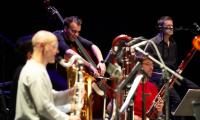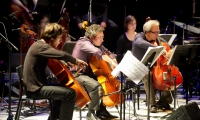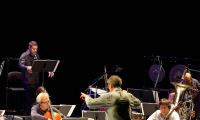Georges-Elie Octors : conductor
Romain Bischoff : voice
Nicolas Crosse : contrabass
Grégory Beller : IRCAM computer music designer :
The Raphaël Cendo's work is commissioned by Françoise et Jean-Philippe Billarant / Ictus
- Prologue
- Premier chant - révélation 8
- Interlude 1
- Deuxième chant - révélation 4
- Interlude 2
- Troisième chant - révélation 13
- Épilogue
Raphaël Cendo: Introduction to Darkness
programme note by the composer
Written between 90 and 100 AD, the Apocalypse of John – Apocalypse meaning laying bare, removal of the veil or Revelation – prophesies an intermingling of events of the past, present and future. This literary style was adopted in the Old and New Testaments in particular (the apocryphal texts) by Daniel, Peter, Elijah, Moses etc….Written between 90 and 100 AD, the Apocalypse of John – Apocalypse meaning laying bare, removal of the veil or Revelation – prophesies an intermingling of events of the past, present and future. This literary style was adopted in the Old and New Testaments in particular (the apocryphal texts) by Daniel, Peter, Elijah, Moses etc….
The Apocalypse of John (The New Testament) is no exception to the rule when describing the end of the world and closes with the vision of the New Jerusalem (the Kingdom of God) which would replace all Kingdoms on earth, forever. The highly symbolic scriptures of the Apocalypse opened the way to several modes of interpretation. Notably: the idealist theory which considers the Apocalypse to be a struggle between good and evil; and the futuristic view which sees in this book a description of events to come, a prophecy. Contrary to general opinion, if there was indeed a Kingdom of the Beast – i.e. Satan, it was only to prepare the world for the arrival of the Kingdom of God.
The Apocalypse is the most controversial textual material in the Scriptures. It appeared at a time when religion was intimately linked to politics, and flashes through visions of pending disaster and descriptions of great cruelty. This text was initially a scripture that sought to help the Christian community through a period of great persecution and to predict the downfall of the Antichrist – a term describing “an impostor, a group or an organisation which, prior to the end of the world, would attempt to establish a religion opposed to that of Jesus Christ”. This would explain why this book circulated secretly and was at first written in a symbolic and even encrypted form of language. The Apocalypse describes not only the end of the world but also the whole history of humanity. The text also serves as a prophecy of the fall of Rome and the collapse of the persecutor, the Roman Empire, and the emergence of Christianity as its replacement.
The issue of the Christian Apocalypse refers to our own Apocalypse (but without any religious connotation), to that of our community as a whole, and also to the more intimate Apocalypse in our own lives. What veil do we want to lift from ourselves, what dark times await us, and what is the Empire that has to be destroyed today?
Introduction to Darkness is structured around three songs rendered in Latin from the 22 Revelations of the Apocalypse of St. John, without following the actual chronological order of the book. The piece opens and closes with a Prologue and an Epilogue. The Prologue and the Epilogue are to be heard in accordance with their original interpretation: “as a prelude to the speech or lyrics (introduction or preface) and to close the production (conclusion or end). These two sections carry within them traces of long-lost voice tones that resemble the floating debris of a language lost forever.
The first song – Revelation 8 – “there was silence in heaven about the space of half an hour”.
These are the seven trumpets of the angels announcing the Flood, hail and fire mixed with blood and the death of life on earth. The text, portraying a horrific vision with unprecedented violence, is dealt with in a musical manner, which goes against the overall context. The music is no more than an echo of a world that has vanished forever.
Second song – Revelation 4 – “Come up hither, and I will show you what will be hereafter”.
The absence of any chronology in the text is due to the fact that I wanted to place a description of the Kingdom of God in the middle of the song. This second song is a terrifying and daunting description of the Kingdom of Heaven – rather than a description of that of Satan. Here, we come across “four beasts, full of eyes before and behind” and the blinding lights flash across the general lexical theme of the song. The music focuses on very shrill sounds, the sole shining light in the entire piece.
Third Song – Revelation 13 – “Then I saw a Beast rise up out of the sea, having seven heads and ten horns, and upon his horns ten crowns, and upon his heads the name of blasphemy”.
The third song is a description of Satan's reign on earth. Incredibly inventive, here we come across “a Beast resembling a leopard, with feet like the feet of a bear, and a mouth as the mouth of a lion” or “a Beast that had two horns like a lamb, but speaking like a dragon”. This was a period when all things evil were worshipped, including blasphemy and the devil’s own number, 666.
The musical display basically consists of the low register instruments. In this set, the double bass soloist has a very special position. Apart from the solo role, the soloist has a more enigmatic task that might be described as an unusual duet with the actual vocalist. Within the orchestra, the role of this soloist stands out from the rest of the group because of the very energetic virtuoso performance, the intense techniques displayed and the use of precise instrumental motions. In the second case, the double bass player accompanies the vocalist by way of a continuous dialogue. Here the role may be defined as the satanic part of the text, like a second interpretation of the voice. The language expressed by the double bass player in this example seeks to create harmony with the vocalist by keeping piece with the nuances and variations of the voice. This arrangement is essential to the piece, the double bass forming the link between the orchestra and the lyrics.
My writing of the script is focused on what I call the infra-saturated. As far as my other works are concerned, advocating a form of total saturation, with energy being the driving force, what stands out here is the suggestion of a world ravaged by excessive energy, where all that remains is a phantom relic of its former self. Infra-saturation represents a world where nothing remains but the distant passing of flames, a world made of ash, leaving a trail of immeasurable energy. This is a period of time haunted by past conflicts and plunged into endless nights. This was described very well by Georges Didi-Humberman when discussing the bomb dropped on Hiroshima (in “Spirit of Case Dismissed”: “Marked forever on the scale of time, that very precise form of pulverisation, that ash form of an object destroyed by fire, lies right on the boundary of two extreme states of things: on the one side, the massive flash that makes the whole sky explode and, on the other, the gargantuan greyness that smothered the whole earth. It is a fine thread that links the period of fire and the covering of ash.”
The concept of saturation carries within it the notion of excess and challenges acts of moderation. Overindulgence in sound and the overload of information pushed to the limit, open the way for new tracks in the formation of tone. Beyond saturation, but still falling within its influence, infra-saturation is nothing more than a reference to its own Darkness, the advent of a dark form of energy, a descent into a saturated state of hell.
I would like to thank the Ictus ensemble for its invaluable contribution to this project; Roman Bishoff for the research work that carried out together and also Gregory Beller. I also wish to thank all those people who have supported this project.
Raphaël Cendo
Introduction aux Ténèbres
programmatoelichting door Raphaël Cendo
Geschreven tussen 90 en 100 na Christus profeteert de Openbaring van Johannes (‘Openbaring’ wil zeggen ‘onthullen’, ‘ontsluieren', ‘Revelatie’) wat gebeurd is, wat gebeurt en wat zal gebeuren. Dit litteraire genre werd vooral uitgewerkt in het Oude en Nieuwe Testament (apocriefe geschriften) door Daniël, Petrus, Elia, Mozes enz…
De Openbaring van Johannes (Nieuwe Testament) ontsnapt niet aan de gebruikelijke beschrijving van het einde der tijden en eindigt met het visioen van een hemels Jeruzalem (het Rijk Gods), dat voor altijd alle aardse Koninkrijken zou vervangen. De symbolische natuur van de Openbaring heeft de weg geopend voor een veelheid aan interpretaties: er is de idealistische stelling die in de Openbaring een strijd ziet tussen het goede en het kwade en de futuristische stelling die in het boek een beschrijving ziet van een profetie, toekomstige gebeurtenissen. In tegenstelling tot de aanvaarde ideeën: als het rijk van Satan moet aanbreken, dan is dit enkel om de komst van het Rijk Gods op aarde beter voor te bereiden.
De Openbaring is de meest controversiële tekst van de Bijbel. Het ziet het daglicht in een tijdperk waarin religie en politiek intiem verbonden zijn en is doorspekt met visioenen van rampen en bijzonder gruwelijke taferelen. Deze tekst was aanvankelijk bestemd om de christelijke gemeenschap te ondersteunen in een tijd waarin deze zwaar werd vervolgd, en om de ondergang te voorspellen van de Antichrist – een term die verwijst naar “een oplichter, een groep of organisatie die zou proberen om net voor het einde der tijden een religie in te voeren die ingaat tegen die van Jezus Christus”. Dit verklaart waarom dit boek geheim in omloop was en in eerste instantie geschreven werd in een symbolische, zelfs gecodeerde taal. De Openbaring roept niet alleen het einde van de wereld op, maar dat van de hele geschiedenis van de mens. De tekst laat zich eveneens gelden als een profetie tegen Rome en het daaropvolgend Romeinse Rijk, ten voordele van de christelijke Kerk die voorbestemd was om haar te vervangen.
De vraag omtrent de christelijke Openbaring verwijst naar onze eigen Openbaring (ontdaan echter van enige religieuze connotatie), namelijk de Openbaring van onze volledige gemeenschap, maar ook die van ons eigen intieme leven. Welke sluier willen wij afleggen, welke donkere uren staan ons te wachten en welk Rijk moet er vandaag vernietigd worden?
Introduction aux Ténèbres is opgebouwd uit drie in het Latijn gezongen liederen gekozen uit de 22 hoofdstukken van de Openbaring van Johannes zonder dat hierbij de chronologische volgorde van het boek gevolgd wordt. Het stuk begint met een Proloog en eindigt met een Epiloog. De Proloog en Epiloog worden hier in hun originele betekenis opgevat, geplaatst vóór het woord (Prologos) en ná het woord (Epilogos). Deze twee delen dragen de overblijfselen van kleine stukjes stem in zich, zoals het puin van een voor altijd verloren taal.
Het eerste Lied – Openbaring 8 – “Het werd stil in de hemel, gedurende ongeveer een half uur.”
Het zijn de zeven trompetten van de engelen die de zondvloed, het vuur, de hagel, het bloed en de dood op aarde aankondigen. De afschuwelijke en buitensporig gewelddadige tekst wordt tegen de muzikale stroom in bewerkt. De muziek is alleen nog maar een echo van een verdwenen wereld.
Tweede lied – Openbaring 4 – “Kom naar hierboven, zodat dat ik je laat zien wat vervolgens moet gebeuren”
De afwezigheid van tekstchronologie komt door het feit dat ik de beschrijving van het Rijk Gods in het midden van het stuk wilde plaatsen. Dit tweede lied is een uitgebreide, angstaanjagende beschrijving van het Hemelse Rijk, eerder dan een beschrijving van dat van Satan. Men treft er ‘vier levenden’ aan ‘die zowel van voor als van achter ogen hebben’ en de tekst wordt doorkruist met een verblindend licht. De muziek condenseert zich in het hoogste register, het enige moment van licht in het hele stuk.
Derde lied – Openbaring 13 - "Toen zag ik een Beest met zeven koppen en tien hoornen uit de zee opdoemen, met tien diademen op de hoornen en blasfemische leuzen op de koppen”
Het derde lied is een beschrijving van de heerschappij van Satan op aarde. Het getuigt van een ongelooflijke vindingrijkheid. Er komen “Beesten” in voor, “een Beest dat op een panter lijkt, met poten als die van een beer en een bek als die van een leeuw” of “een Beest met twee hoorns als een lam, maar dat spreekt zoals een draak”. Het is het rijk van de aanbidding van het kwade, van de blasfemie en van 666, het cijfer van de duivel.
De muzikale opstelling bestaat voornamelijk uit de ‘lagere’ instrumenten. De solo contrabas neemt er een bijzondere plaats in. Naast de rol als solist heeft ze een enigmatische functie die we zouden kunnen beschrijven als de vreemde dubbelganger van de stem. In haar concerterende rol zet ze zich af tegen de rest van het ensemble via een zeer energetisch en virtuoos spel, extreme speeltechnieken en het inzetten van precies bepaalde instrumentale gestes. In het tweede geval begeleidt de contrabas de stem door ononderbroken met haar in dialoog te gaan. Hier kan men haar rol beschrijven als het vervloekte deel van de tekst, als een tweede vertolking van de stem. De tekst van de contrabas zoekt naar een fusie met de stem door haar intonaties te volgen. Deze positie is primordiaal voor het stuk, waarbij de contrabas de verbinding tot stand brengt tussen het instrumentaal ensemble en de tekst.
Het schriftuur concentreert zich op dat wat ik het infra-gesatureerde noem. Ten opzichte van mijn andere stukken waarin ik gewerkt heb aan de totale saturatie gedreven door energie, wordt dit stuk overheerst door het oproepen van een universum dat vernietigd is door een te grote energie en waarin er alleen nog maar iets spookachtigs overblijft van datgene wat geweest is. De infra-saturatie is een wereld waarin er niets meer overblijft dan de doortocht van vlammen in een ver verleden, een wereld opgericht uit as, het spoor van een energie die geen grenzen kent. Het is het koninkrijk van oorden die achtervolgd worden door verscheuringen uit het verleden die de oneindige nacht ingaan. Het is, zoals Georges Didi-Humberman in “Génie du non-lieu” heel mooi zegt over de bom op Hiroshima: “De schaalafdruk, deze haarfijne verpulvering, deze asvorm van een door het vuur verzwolgen voorwerp, situeert zich precies op de grens tussen twee extreme toestanden: enerzijds doet een gigantische flits de hemel exploderen en anderzijds doet de reusachtige somberheid de hele aarde verstikken. Een broze draad gespannen tussen het rijk van het vuur en dat van de as.”
Het concept van de verzadiging draagt de notie van overdaad in zich en verwerpt elke tussenoplossing. De overdaad aan klanken en informatie, tot uitputting toe, opent een weg om de klankkleur in een nieuwe richting te bewerken. Net zoals de verzadiging is de infra-saturatie niet meer dan de oproeping van haar eigen Duisternis, de komst van een zwarte energie, een afdaling naar de hel van haar verzadigde toestand.
Ik dank Ictus voor de waardevolle hulp bij dit project, Romain Bischoff voor ons gezamenlijk opzoekwerk, evenals Gregory Beller en alle anderen die dit project hebben gesteund.
Raphaël Cendo
Note de programme
note de programme de Raphaël Cendo
Écrit entre 90 et 100 après Jésus-Christ, l’Apocalypse de Jean (Apocalypse étant la transcription d’un terme grec signifiant mise à nu, enlèvement du voile ou révélation) prophétise sur ce qui est arrivé, sur ce qui arrive et sur ce qui doit arriver. L'apocalyptique est un genre littéraire particulièrement développé dans l’Ancien Testament (livre de Daniel) et dans les livres apocryphes du Nouveau Testament par Daniel, Pierre, Élie et Moïse notamment.
Ainsi, l’Apocalypse de Jean décrit la fin des temps et se conclut par la vision d’une Jérusalem céleste (le royaume de Dieu) qui remplacerait pour toujours les royaumes terrestres. L’écriture hautement symbolique de ce texte a ouvert la voie à une multitude d’interprétations, notamment la thèse idéaliste qui y voit un combat entre le bien et le mal, et la thèse futuriste qui y voit une peinture des événements à venir, une prophétie. Contrairement aux idées reçues, si le royaume de la bête – Satan – doit survenir, ce n’est que pour mieux préparer l’arrivée du royaume de Dieu sur terre. L’Apocalypse est le texte le plus controversé des Écritures. Il a vu le jour à une époque où la religion était intimement liée à la politique ; il est traversé par des visions de désastres et des descriptions d’une grande cruauté. Ce texte fut tout d’abord destiné à soutenir la communauté chrétienne en temps de grande persécution et à prédire la ruine de l’Antéchrist (terme désignant « un imposteur, un groupe ou une organisation qui tenterait, peu avant la fin du monde, de mettre en place une religion opposée à celle de Jésus-Christ »). Il circula tout d’abord, secrètement, dans un langage symbolique et chiffré. Mais l’Apocalypse évoque également toute l’histoire de l’humanité ; il s’affirme comme une prophétie contre Rome et l’empire romain persécuteur et en faveur de l’Église chrétienne destinée à le remplacer.
La question de l’apocalypse chrétienne renvoie à notre propre apocalypse (mais débarrassée de toute connotation religieuse), à celle de notre communauté, mais aussi à celle de notre propre vie. Quel voile voulons-nous lever ? Quelles heures sombres nous attendent ? Et quel est aujourd’hui cet empire à détruire ?
Introduction aux ténèbres se structure en trois chants chantés en latin, issus des vingt-deux révélations de l’Apocalypse de Jean, sans suivre l’ordre chronologique du livre. La pièce débute par un prologue et se conclut par un épilogue ; le prologue se situant avant la parole (prologos) et l’épilogue, après (epilogos). Ces deux parties portent en elles des restes de granulation électronique de la voix, comme des décombres d’une langue à tout jamais perdue.
Premier chant – révélation 8
« Il se fit un silence dans le ciel d’environ une demi-heure. »
Ce sont les sept trompettes des anges qui annoncent le déluge, le feu, la grêle, le sang et la mort sur terre. Le texte, d’une vision horrible et d’une violence inouïe, est traité musicalement à contre-courant. La musique n’est plus qu’un écho d’un monde évanoui.
Deuxième chant – révélation 4
« Monte ici que je te montre ce qui doit arriver par la suite. »
La raison de la non chronologie du texte réside dans le fait que je voulais placer la description du royaume de Dieu au centre de la pièce. Ce deuxième chant est une description terrifiante du royaume des cieux – bien plus que celle du royaume de Satan. On y croise « quatre vivants constellés d’yeux par-devant et par-derrière » et le champ lexical est celui de la lumière. La musique se focalise sur des sons suraigus, seuls moments lumineux de l’œuvre.
Troisième chant – révélation 13
« Alors je vis surgir de la mer une Bête ayant sept têtes et dix cornes, sur ses cornes dix diadèmes, et sur ses têtes des titres blasphématoires. »
Il s’agit d’une description du règne de Satan sur terre. On y croise « une bête ressemblant à une panthère, avec les pattes comme celles d'un ours et la gueule comme une gueule de lion », « une bête avec deux cornes comme un agneau, mais parlant comme un dragon ». C’est le règne de l’adoration du mal, du blasphème et du chiffre du diable, le 666. Le dispositif musical est essentiellement constitué d’instruments graves, où la contrebasse solo tient une place particulière. En plus de son rôle soliste, elle a une fonction plus énigmatique qui double étrangement la voix. Dans son rôle concertant, elle se démarque du reste de l’ensemble par un jeu très énergique et virtuose, par des techniques de jeux extrêmes et par l’utilisation de gestes instrumentaux précis. Dans le deuxième cas de figure, la contrebasse est en dialogue constant avec la voix. On peut définir son rôle comme la part maudite du texte, comme une deuxième interprétation de la voix. L'écriture de la contrebasse recherche alors à fusionner avec la voix en suivant ces inflexions. Le rôle de la contrebasse est donc primordial dans la pièce, car elle fait le lien entre l’ensemble instrumental et le texte.
Le travail d’écriture que j’ai mené se focalise sur ce que j’appelle « l’infrasaturé ». Par rapport à mes œuvres précédentes – qui proposent un travail sur une saturation totale dont l’énergie est le moteur –, ce qui prédomine ici est plutôt un univers dévasté par une trop grande énergie et dans lequel il ne reste qu’une survivance fantomatique de ce qui a été. L’« infra-saturation » est un monde où il ne reste plus que le passage lointain des flammes, un monde de cendres, l’évocation d’une énergie considérable. C’est le règne des lieux hantés par les déchirements du passé et plongés dans des nuits infinies. C’est, comme le dit Georges Didi-Huberman à propos de la bombe d’Hiroshima dans son livre Génie du non-lieu : « L’empreinte de l’échelle, cette précise pulvérisation, cette forme cendre d’un objet détruit par le feu, se situe à la frontière exacte de deux états de choses extrêmes : d’un côté, l’éclair gigantesque faisant exploser tout le ciel et de l’autre, la grisaille gigantesque faisant étouffer toute la terre. Fil fragile tendu entre le règne du feu et celui de la cendre. » Le concept de saturation porte en lui la notion d’excès. L’excès de sons et l’excès d’informations portés jusqu'à épuisement ouvrent la voie à de nouvelles pistes sur le travail du timbre. En deçà de la saturation mais toujours portée par elle, l’« infra-saturation » n’est que l’évocation de ses propres Ténèbres, l’avènement d’une énergie noire, une descente aux enfers de sa condition saturée.
Je voudrais remercier l’ensemble Ictus pour son aide précieuse, Romain Bischoff pour le travail de recherche que nous avons fait ensemble et Grégory Beller. Je remercie également les personnes qui ont soutenu ce projet.



